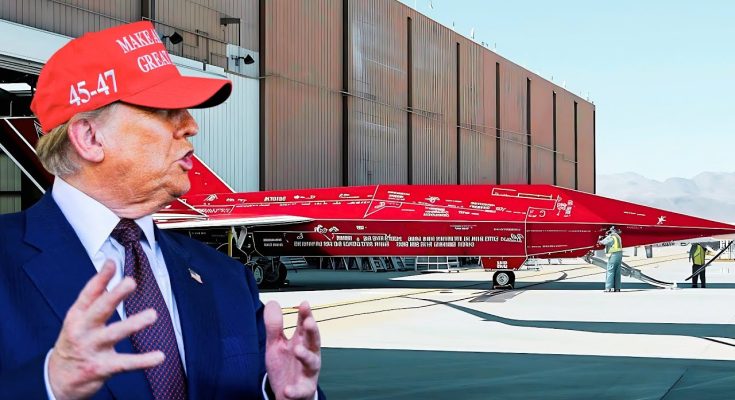For years, the SR-72 Darkstar has hovered in the realm of myth, whispered about in defense circles and speculated upon by aviation enthusiasts. But now, this once-distant dream of hypersonic flight is becoming a reality, with the SR-72 Darkstar scheduled for development and potential deployment in 2025. Created by Lockheed Martin’s Skunk Works division—the same team behind the legendary SR-71 Blackbird—the SR-72 promises to be the next giant leap in aviation technology, pushing the boundaries of speed and performance to unprecedented levels.
The SR-72 Darkstar: What Is It?
The SR-72 Darkstar is designed to be a hypersonic, unmanned reconnaissance aircraft that can reach speeds greater than Mach 6—or six times the speed of sound. This makes it significantly faster than anything currently in operation, including the SR-71 Blackbird, which once held the title of the world’s fastest aircraft at Mach 3.3. The Darkstar’s design combines cutting-edge materials, aerodynamic principles, and propulsion systems to achieve speeds that were once thought unattainable.
What sets the SR-72 apart from previous aircraft is its role as a reconnaissance and strike platform, capable of operating in highly contested environments with little to no chance of detection. The aircraft is designed to fly at extremely high altitudes, where it can gather critical intelligence or carry out high-speed strikes with pinpoint precision. Its high-speed capabilities, paired with its stealth features, make it an incredibly potent asset in the U.S. Air Force’s arsenal.
The Hypersonic Revolution: Unmatched Speed and Capability
The SR-72’s hypersonic speed is one of its most significant features. At speeds exceeding Mach 5, the Darkstar can travel at over 3,800 miles per hour, which is roughly five times faster than the speed of sound. This kind of velocity is a game-changer for modern warfare, allowing the aircraft to cover vast distances in a fraction of the time it takes conventional fighter jets or bombers. Such speeds would allow the SR-72 to rapidly respond to emerging threats and penetrate hostile airspace without being intercepted by existing missile defense systems.
To achieve these speeds, the SR-72 is powered by a dual-mode ramjet engine—a combination of a turbojet and a ramjet. This engine can operate efficiently at both subsonic and hypersonic speeds, enabling the aircraft to transition seamlessly between different flight regimes. The propulsion system, combined with advanced heat-resistant materials, will ensure that the SR-72 can sustain its hypersonic flight without encountering the issues that have plagued previous hypersonic prototypes, such as heat buildup and structural integrity concerns.
Why the SR-72 Is So Revolutionary
The SR-72 Darkstar represents a major leap in air combat and reconnaissance capabilities. Its hypersonic speed means it could outpace current missile-defense systems, making it nearly impossible for adversaries to intercept. The aircraft’s combination of speed, stealth, and advanced avionics allows it to conduct long-range reconnaissance missions over enemy territory, collecting intelligence without being detected. This is especially critical in situations where rapid, real-time data collection is needed for military decision-making.
Additionally, the SR-72 could be used for precision strike missions, targeting high-value enemy assets such as command centers or missile sites. With its speed and stealth, it could reach these targets faster than any other system, carrying out strikes with surgical precision and minimal opportunity for counterattack.
Beyond the battlefield, the SR-72’s speed could revolutionize space and air travel, offering a platform that could rapidly launch satellites into orbit or conduct high-speed, long-range transport operations. Its potential applications are virtually limitless, and its development is poised to have a profound impact on the aerospace industry as a whole.
The SR-72 Darkstar and National Security
In terms of national security, the SR-72 Darkstar provides the U.S. with a decisive technological advantage. With its unmatched speed and reconnaissance capabilities, the SR-72 would be an invaluable tool for intelligence gathering, surveillance, and reconnaissance (ISR) missions in areas where conventional aircraft would be vulnerable to enemy defenses. Furthermore, its ability to carry out precision strikes could play a critical role in modern warfare scenarios, where the ability to strike swiftly and decisively is paramount.
The SR-72 also strengthens the U.S. position in the growing global competition for hypersonic weapons. While countries like Russia and China are making strides in developing their own hypersonic technologies, the SR-72 puts the U.S. firmly at the forefront of this new arms race.
Looking Ahead: What’s Next for the SR-72?
As Lockheed Martin prepares for the SR-72’s development and testing, the aviation world is watching closely. If all goes according to plan, the SR-72 Darkstar could enter service by 2025, marking the dawn of a new era in aviation technology. Its combination of hypersonic speed, stealth, and precision strike capability makes it a force to be reckoned with, capable of changing the nature of warfare and intelligence-gathering operations.
While the SR-72 may still be a few years away from operational status, its impending arrival signals a profound shift in the capabilities of modern air forces. The Darkstar could not only revolutionize military aviation but also have a lasting impact on the global balance of power, as nations race to develop their own hypersonic technologies in response. The SR-72 Darkstar is no longer a myth; it’s coming, and it’s set to change everything.



